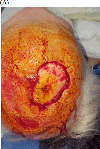Current and Future Developments in Wound Healing
- PMID: 37308128
- PMCID: PMC11121504
- DOI: 10.1055/s-0043-1769936
Current and Future Developments in Wound Healing
Abstract
Poor wound healing on the face and neck can lead to significant morbidity and dissatisfaction in facial plastic surgery. With current advances in wound healing management and commercially available biologic and tissue-engineered products, there are several options available to optimize acute wound healing and treat delayed or chronic wounds. This article summarizes some of the key principals and recent developments in wound healing research in addition to potential future advancements in the field of soft tissue wound healing.
Thieme. All rights reserved.
Conflict of interest statement
None declared.
Figures





Similar articles
-
A contemporary review of wound healing in otolaryngology: current state and future promise.Laryngoscope. 2009 Nov;119(11):2099-110. doi: 10.1002/lary.20561. Laryngoscope. 2009. PMID: 19572395 Review.
-
New developments in wound healing relevant to facial plastic surgery.Arch Facial Plast Surg. 2008 Nov-Dec;10(6):402-6. doi: 10.1001/archfaci.10.6.402. Arch Facial Plast Surg. 2008. PMID: 19018061 Review.
-
Complex Wound Management.Facial Plast Surg. 2019 Dec;35(6):672-677. doi: 10.1055/s-0039-1700889. Epub 2019 Nov 29. Facial Plast Surg. 2019. PMID: 31783426
-
An algorithmic approach for managing orthopaedic surgical wounds of the foot and ankle.Clin Orthop Relat Res. 2014 Jun;472(6):1921-9. doi: 10.1007/s11999-014-3536-7. Epub 2014 Feb 28. Clin Orthop Relat Res. 2014. PMID: 24577615 Free PMC article.
-
Tissue Engineered Skin and Wound Healing: Current Strategies and Future Directions.Curr Pharm Des. 2017;23(24):3455-3482. doi: 10.2174/1381612823666170526094606. Curr Pharm Des. 2017. PMID: 28552069 Review.

